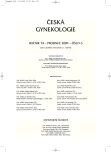Complications of laparoscopic and laparotomic treatment of endometrial cancer
Authors:
Milan Kudela; R. Pilka; P. Hejtmánek; Ľ. Michnová
Authors‘ workplace:
Gynekologicko-porodnická klinika klinika LF UP a FN Olomouc, přednosta doc. MUDr. R. Pilka, Ph. D.
Published in:
Ceska Gynekol 2009; 74(6): 459-463
Overview
Objective:
The aim of the study is to compare advantages, disadvantages and complications of the laparoscopic and clasical laparotomic operations in the patients treated for endometrial carcinoma at our Department and to find out the optimal strategy.
Design:
Retrospective study.
Settings:
Department of Gynaecology and Obsterics, Medical Faculty, Palacky University and University Hospital, Olomouc.
Material and methods:
A total of 165 endometrial cancer patients were operated on since 2004 till 2008 at our department. The clasical laparotomic approach was used in 141 patients and 24 were operated laparoscopically. Both groups were comparable in clinical staging and other parameters. The clinical parameters compared were the frequency of inflammatory complications, urinary passage injury, blood loss, transfusions, operating time and hospital stay.
Results:
The average operating time for laparotomic operations was 137 minutes and for the laparoscopic ones 175 minutes. The mean hospital stay after clasical operation was 7,8 days, and 6,7 days after laparoscopy. The estimated blood after clasical operation was 410 ml and 8,5 % of patients received blood transfusion. Blood loss after laparoscopy was only 214 ml but 12,5 % of patients necessitated blood transfusion. Complications due to infection were more often in patients with laparotomy (5,7 %) while they occured only in 4,1 % after laparoscopies. The injury of the urinary tract was recorded only in l patient (0,7 %) in the laparotomy group while it was more frequent in the laparoscopic group (2 patients i.e. 8,3 %).
Conclusions:
The main advantage of laparoscopy at the operations of the endometrial cancer is the shorter hospital stay resulting in lower costs, less postoperative discomfort and a minimum of inflammatory complications. On the other hand there were more frequent urinary tract injuries and the operating time was usually longer at laparoscopies compared to laparotomies. Nevertheless, it seems that the use of the laparoscopic operations for endometrial cancer will probably be increasing.
Key words:
endometrial cancer, laparoscopy, laparotomy, operative complications.
Sources
1. Barakat, RR., Lev, G., Hummer, A.J., et al. Twelve-year experience in management of endometrial cancor: A change in surgical and postoperative radiation approaches. Gynecol Oncol 2007, 105, p. 150-156.
2. Eltabbakh, GH., Shamonki, MI., Moody, JM.,Garafano, LL. Hysterectomy for obese women with endometrial cancer: laparoscopy or laparotomy ? Gynecol Oncol 2000, 78, p. 329-335.
3. Gil-Moreno, A., Diaz-Feijoo, B., Morchon, S., Xercavins, J. Analysis of survival after laparoscopic-assisted vaginal hysterectomy compared with the conventional abdominal approach for early-stage endometrial carcinoma: a review of the literature. J Minim Invasive Gynecol 2006, 13, p. 26-35.
4. Holub, Z., Bartoš, P., Eim, J., et al. Laparoscopic surgery for endometrial cancer: long-term results of multicentric study, Eur J Gynaecol Oncol 2002, 23, p. 305-310.
5. Kalogiannidis, I., Lambrechts, S., Amant, F., et al. Laparoscopy – assisted vaginal hysterectomy compared with abdominal hysterectomy in clinical stage I endometrial cancer: safety, recurrence, and long-term outcome. Am J Obstet Gynecol 2007, 198, p. 147-348.
6. Kitchner, H., Swart, AM., Qian, Q., et al. Efficacy of systematic pelvic lymphadenectomy in endometrial cancer (MRC ASTEC trial): a randomised study. Lancet 2009, 373, p. 125-136.
7. Obermair, A, Manolitsas, TP., Leung, Y., et al. Total laparoscopic hysterectomy for endometrial cancer: patterns of recurrance and survival. Gynecol Oncol 2004, 92, p. 789-793.
8. Palomba, S., Falbo, A., Mocciaro, R., et al. Laparoscopic treatment for endometrial cancer: a metaanalysis of randomized controlled trials (RCTs) . Gynecol Oncol 2009, 112, p. 415-421.
9. Schlaerth, AC., Abu-Rustum, NR. Role of minimally invasive surgery in gynecologic cancers. Oncologist 2006, 11, p. 895-901.
10. Scribner, DR., Walker, JR., Johnson, GA., et al. Surgical management of early-stage endometrial cancer in the elderly: is laparoscopy feasible? Gynecol Oncol 2001, 86, p. 563-568.
11. Seracchioli, R., Venturoli, S., Ceccarin, M., et al. Is total laparoscopic surgery for endometrial carcinoma at risk of local recurrence ? A long term survival. Anticancer Res 2005, 25, p. 2423-2428.
12. Tozzi, R., Campanile, RG. Role of laparoscopy in the treatment of patiens with endometrial cancer. Gynecol Surg 2007, 4, p. 239-242.
13. Uccella, S., Laterna, R., Ciravolo,G., et al. A comparison of urinary complications following total laparoscopic radical hysterectomy and laparoscopic pelvic lymphadenectomy to open abdominal surgery. Gynecol Oncol 2007, 107, p. 147-149.
Labels
Paediatric gynaecology Gynaecology and obstetrics Reproduction medicineArticle was published in
Czech Gynaecology

2009 Issue 6
Most read in this issue
- Prenatal intracranial hemorrhagie – diagnosis and follow-up
- Amniotic fluid interleukin 6 levels in preterm premature rupture of membranes
- Ovarian torsion in the first trimester gravidity after stimulation in vitro fertilization – case report
- Fertility preserving treatment of gynecological malignant tumors
